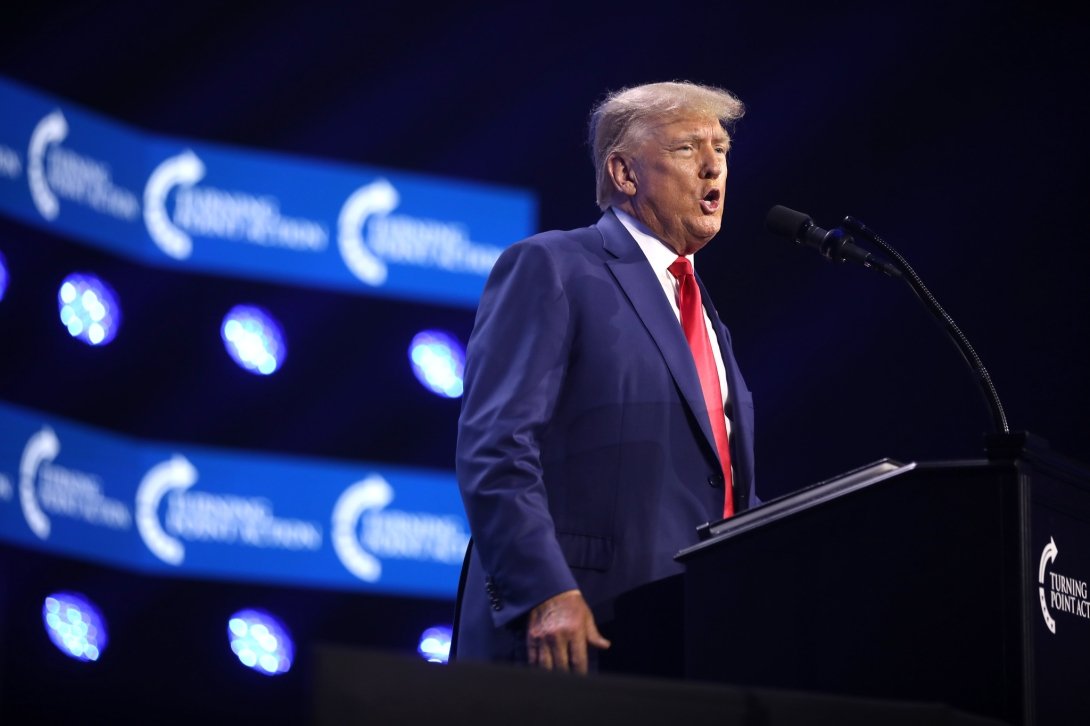World Press Freedom Day Marks Grave Threats from Trump and Other Leaders

The second Trump administration has carried out a systematic campaign to intimidate journalists, defund independent media outlets and weaponize government power against the press.
Flickr user Gage Skidmore
While World Press Freedom Day is global in scope, its urgency is being felt even more deeply this year in the United States.
The second Trump administration has attacked journalists, threatened some of the country’s most prestigious media outlets, introduced laws that limit access to public records and spread general distrust of the critical work reporters across all formats produce daily. These actions weaken the press’ ability to inform the public and hold power to account. It also puts freedom of the press — an essential American right — at risk.
World Press Freedom Day finds the Trump administration targeting journalists and journalism
The White House issued an executive order calling for the end of federal support for the Corporation for Public Broadcasting. Trump is also pushing Congress to rescind more than $1 billion in already-approved funding for the CPB and is trying to remove CPB board members for no legally justifiable reason.
FCC Chairman Brendan Carr threatened to revoke CBS’ broadcast licenses following a 60 Minutes interview with then-Vice President Kamala Harris, claiming it violated the FCC’s “news distortion doctrine.” Trump also filed a $20 billion lawsuit against CBS’ parent company, Paramount.
The FCC reopened complaints against ABC and NBC for their coverage of Trump while dismissing similar complaints against Fox News — indicating a partisan application of regulatory power.
Carr initiated investigations into Comcast NBCUniversal and Verizon over their diversity, equity and inclusion programs — and suggested that he would block mergers from companies with such initiatives.
The White House barred Associated Press reporters from press briefings after the outlet refused to call the Gulf of Mexico the “Gulf of America,” leading to the AP filing a successful lawsuit alleging unconstitutional retaliation. The administration has since restricted all wire services — including the AP and Reuters — from participating in the White House’s daily press pool.
The Department of Justice revoked protections for journalists, allowing prosecutors to subpoena reporters’ records in leak investigations.
The administration tried to shut down the Voice of America, which broadcasts news in 49 languages worldwide, and claw back $12 million in funding for Radio Free Europe/Radio Liberty. Courts blocked the attempt to shut down VOA and issued a temporary restraining order forcing the administration to restore funding to Radio Free Europe/Radio Liberty.
Taken together, these actions reveal a systematic campaign to intimidate journalists, defund independent media outlets and weaponize government power against the press. In his testimony to Congress, Free Press Action Co-CEO Craig Aaron called the White House’s coordinated censorship campaign a “free speech emergency.”
As an April report from the Committee to Protect Journalists (CPJ) states, “The first 100 days of the Trump administration have been marked by a flurry of executive actions that have created a chilling effect and have the potential to curtail media freedoms. These measures threaten the availability of independent, fact-based news for vast swaths of America’s population.”
“ … CPJ has noted a significant increase in the number of newsrooms seeking safety advice, concerned that the changing national political environment could threaten their ability to report without fear of retribution from authorities.”
Authoritarians target the press
The deterioration of press freedom in the United States is part of a broader global trend. Around the world, journalists are being silenced through intimidation, censorship, surveillance and violence. These trends aren’t limited to authoritarian states. As the 2025 World Press Freedom Index notes, democracies are increasingly adopting similar tactics to suppress dissent and control public narratives.
Around the world, governments are jailing, harassing or even killing journalists just for doing their jobs. These examples show how widespread and dangerous the crackdown has become:
In Gaza, between Oct. 7, 2023, and March 26, 2025, at least 232 journalists and media workers were killed. This makes it the deadliest conflict for journalists in modern history.
In 2024, a record 124 journalists were killed, and at least 361 journalists were incarcerated. The figure reflects rising global risks for reporters working under authoritarian regimes.
In Turkey, Swedish journalist Joakim Medin was convicted of insulting President Recep Tayyip Erdoğan and received a suspended sentence. He remains detained on separate terrorism charges that could carry up to nine years in prison.
In Russia, Ukrainian journalist Viktoriia Roshchyna was abducted and later died in Russian custody. She had been reporting on illegal detention sites near the Zaporizhzhia nuclear plant.
In Azerbaijan, seven journalists from Abzas Media and Radio Free Europe/Radio Liberty were put on trial for smuggling. The defendants say the charges were fabricated in retaliation for their reporting.
In Haiti, at least 10 journalists were attacked while covering a major protest in March 2025. Reporters say wearing press vests has made them more visible and more vulnerable.
In Hungary, Prime Minister Viktor Orbán vowed to continue his 15-year campaign against press freedom, saying that the country must stop the “shadow army” of journalists and others who cater to the interests of the EU and a “liberal American empire.”
Press freedom is democracy’s early warning system
What’s happening in the United States is not separate from what we’re seeing in Azerbaijan, Gaza, Haiti, Hungary and Russia. It is part of the same authoritarian impulse to control what the public knows, punish those who report it and rewrite the rules of accountability. Attacks on journalism are attacks on democratic self-governance.
The stakes could not be higher. Without a free press, people are left with propaganda, disinformation and silence. We lose the ability to question those in power, expose injustice and tell the truth about our communities and the world.
This World Press Freedom Day, we are reminded that press freedom doesn’t erode overnight. It is dismantled piece by piece — until suddenly, it is gone.
Help Free Press keep fighting to protect press freedom: Donate today.